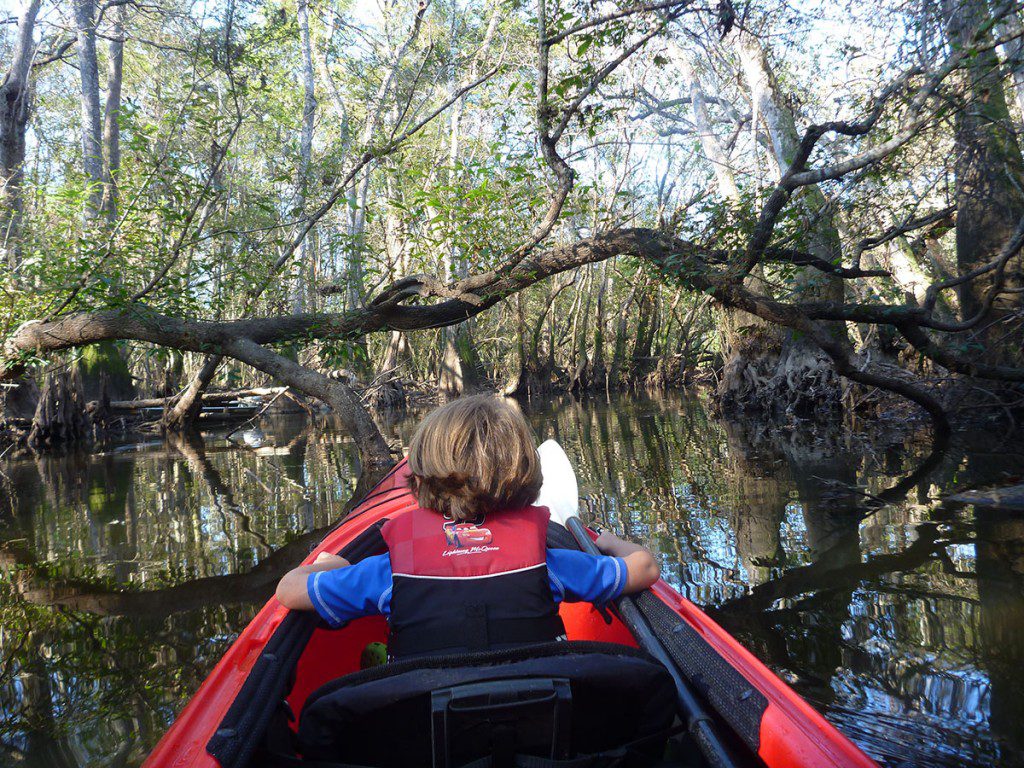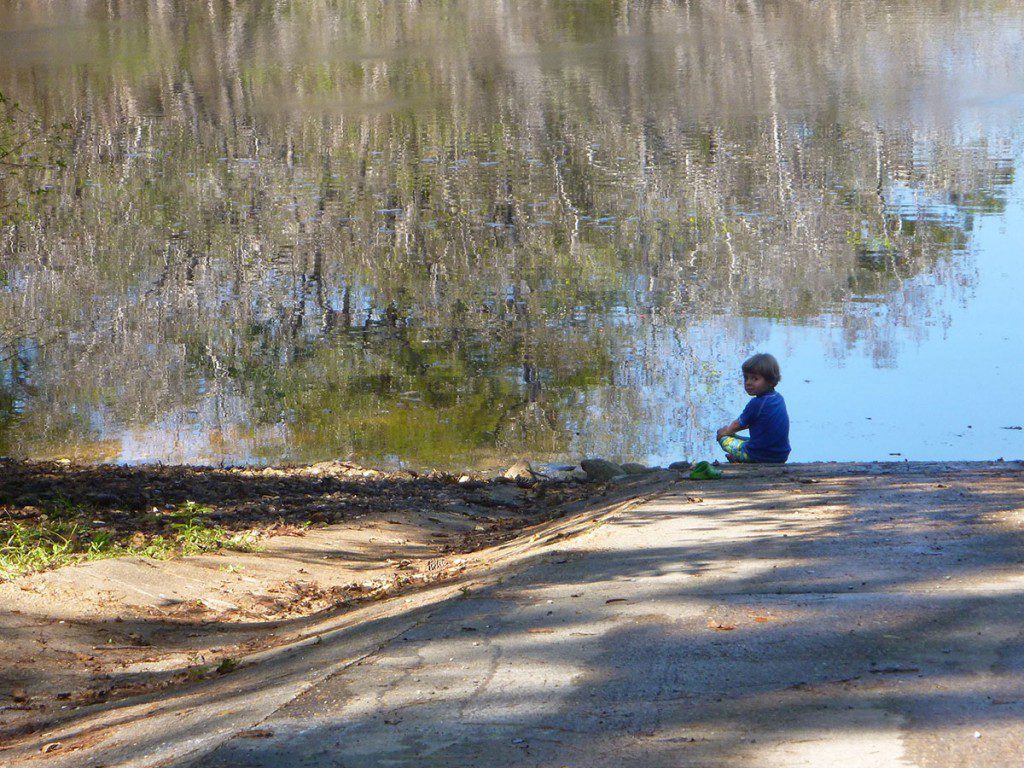Over the last two years, WFSU’s Rob Diaz de Villegas has documented the RiverTrek kayak journeys down the Apalachicola River. While he didn’t participate in this year’s paddle, he was able to tag along for a small stretch. He took with him the biggest fan of the work he produced on those trips- his son Max. Camping and kayaking with a three-year-old has its challenges, but can be rewarding in many ways.
Rob Diaz de Villegas WFSU-TV
Pulling into the Hickory Landing campsite on Owl Creek, I’m happy to see so many familiar faces. It’s the final night of RiverTrek 2014, and the paddlers’ families have been invited to camp out and see their loved ones off as they make the final approach towards Apalachicola. Some of us are here as part of the extended RiverTrek family, such as fellow ’12 paddlers Jennifer Portman and Chris Robertson, who were nice enough to bring a tandem kayak that I could use to explore Owl Creek with my son Max. If my participation in RiverTrek has reached one person, gotten just one person interested in the Apalachicola River, or in paddle sports, it’s this kid. And I couldn’t be happier to have him get a taste of the RiverTrek experience. But first I have to wake him up.
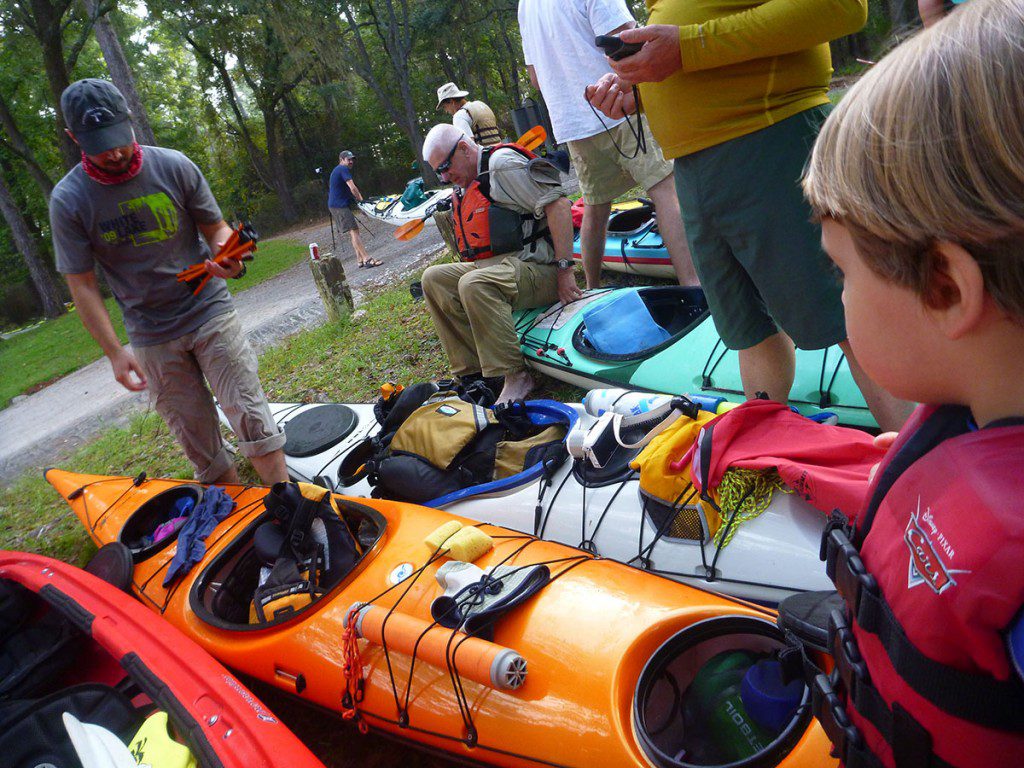
RiverTrek 2014 paddlers getting ready to complete the final leg of their journey, from Owl Creek to Apalachicola.
We made a two-hour drive down highway 20 and then through the Apalachicola National Forest on State Road 65. Max misses all of this. He wakes up hungry, so I give him what is now my go to camping and kayaking snack for him, a conveniently self-packaged banana.
“Is monkey eating his banana?” RiverTrek coordinator Georgia Ackerman says to Max, still drowsy in his car seat.
“Ooh-ah-ah,” he says. This is his greeting of choice as I take him through the camp. We see other ‘Trekkers I’ve had the pleasure of paddling with over the last couple of years, such as Doug Alderson, Josh Bolick, and Tom Herzog (whom I initially met while interviewing about his beer can canoe). Max remembers Katie McCormick from our Wakulla River trip, and even the host of WFSU-TV’s Dimensions, Julz Graham, is part of this year’s adventure. RiverTrek founder Earl Murrogh is visiting the group, witnessing his vision continue to evolve and raise awareness of the river he loves.
RiverTrek is a five day paddle benefiting the Apalachicola Riverkeeper. Participants (except for Jennifer and I, who cover the event as media) get pledges from friends and neighbors and then paddle 107 miles down the river. Three of those miles are the trip into and out of Owl Creek, to a campsite in the National Forest. For the first three days of the trip, ‘Trekkers camp on sand bars directly on the river. These are abundant between the Woodruff Dam, where the river starts, and Wewahitchka. South of Wewa, sandbars start to disappear and more creeks, small rivers, and other channels join the Apalach as it flows into Apalachicola Bay. This is why paddlers go 1.5 miles off of the river to sleep on that last night. Those 1.5 miles would be Max’s taste of RiverTrek.
I struggle to set up our tent while keeping my three-year-old from running off to join all of the action. As it was when I was last here, everyone is in high spirits from having paddled 80+ miles together so far. They’ve shared experiences that will become the stories told by those who repeat the trip in years to come. Add those of us who’ve been here before and are equally stoked to be back, and things are bound to get a little festive.
Chris walks by in the forest just beyond our campsite, looking for firewood. Like any three-year-old would, Max sees someone picking up big sticks and decides that’s what he should be doing, too. So off we go. We’re not on any trail, so I have to pick Max up once or twice as he runs and gets his foot caught on a vine. He’s unfazed.
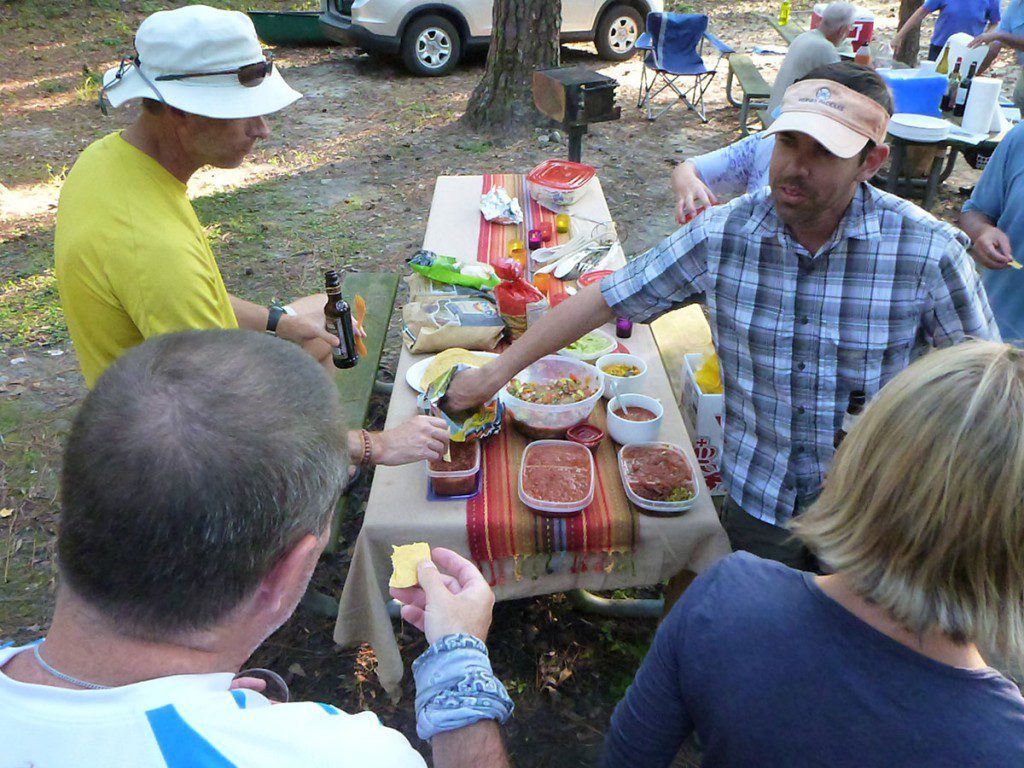
Hickory Landing campsite on RiverTrek 2012. On the last night of the trip, paddlers get a good hot meal and enjoy themselves before heading back to the real world.
For dinner, we eat some delicious chili and vegetable lasagne made by Riverkeeper board members Joyce Estes and John Inzetta. Captain Gill Autrey then takes us out on the Lily, the river cruise boat he volunteers every year as a support vessel. We sit in the upper deck, from which many of the paddlers dive into Owl Creek for a little swim. Then, back to the campsite for some stories.
Georgia roasts a marshmallow for Max to make a s’more, which Max calls a “marshmallow swammich.” Thank goodness for wet wipes.
Doug tells a couple of ghost stories based on his outdoor Florida adventures. I don’t think Max fully understands the scary part of Doug’s tales, but someone is standing by a fire telling stories, so he enjoys it. After the stories is the typical fireside banter. “There is a three-year-old present,” Georgia reminds people.
Then Max starts rubbing his eyes and I feel it is time to get him back to the tent. But first, a bathroom break that turns out to be something of a mini-epic.
Hickory Landing does not have any running water. There is however, a composting toilet, which is slightly more luxurious than just going out in the woods. If you’re able to ignore what you see in the deep chasm beneath the bowl, and tolerate the smell, it’s not bad. But Max sees a big smelly hole he might fall in. And he doesn’t want to stand to pee because he doesn’t really like what he sees.
So we take to the woods.
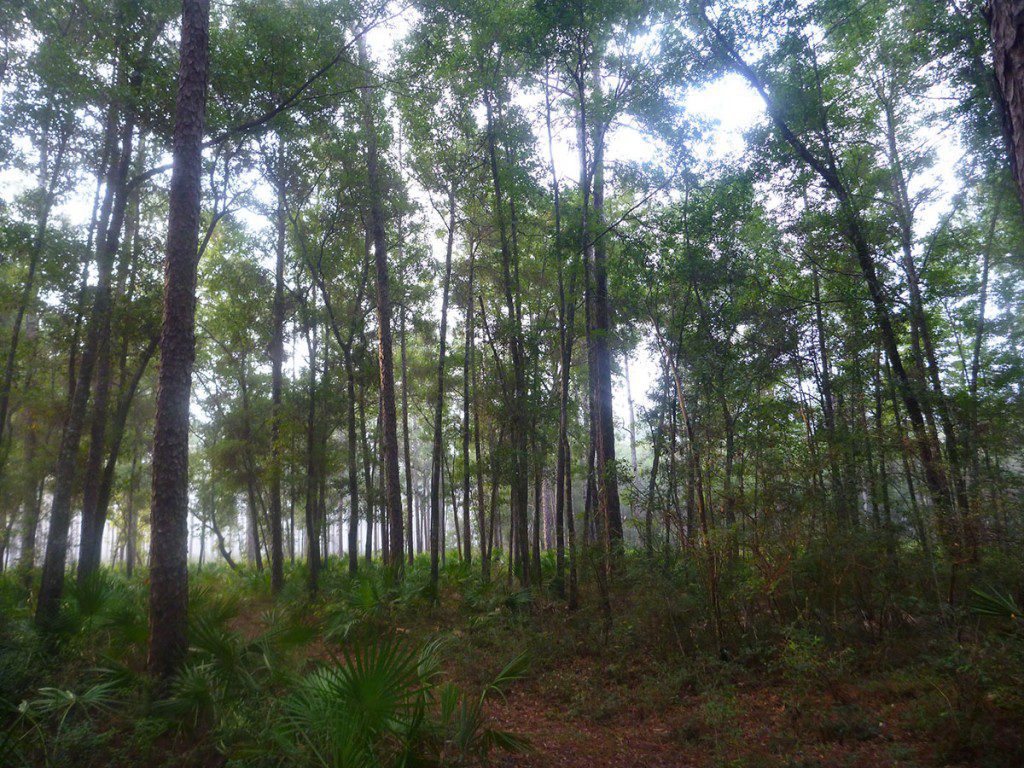
The Apalachicola National Forest by our campsite at Hickory Landing. The fog dissipates before we disembark.
I have in previous months prepared him for the fact that camping means having to pee on trees sometimes. We walk out into the woods and I shine my headlamp on several candidates.
“That tree is beauty-ful. I don’t want to pee on a tree that is beauty-ful.” Evidently every tree in the Apalachicola National Forest is “Beauty-ful.” I keep looking for trees with drooping leaves, or even broken branches lying on the ground. I see what looks like a dead tree, and am reminded of his sympathy for dead trees (he once tried to get me to buy a dead cactus at Home Depot so that we could bring it home and water it back to life).
As often happens when raising a three-year-old, I’m stuck. He’ll tell me he can hold it, and then we’ll go back to the tent and sleep in the same open sleeping bag. I know how that story ends.
Then I see a double tree, two trunks growing from the same base.
“Max, look at that. A double tree.”
“It is a double tree!”
“Double trees are what monkeys pee on. They pee between the two trees.”
And that’s the story of how I woke up in a dry sleeping bag the next morning.
We get back to the tent and I read him a story by headlamp. When that is done, he’s too excited and doesn’t seem like he’ll settle down. Again I’m stuck, but luckily we’re in a place called Owl Creek.
“Max, do you hear that?”
We stop and hear a nearby hoot.
“It’s an owl!”
It lets out one long hoot, and then another, and then utters what Max knows to be the catch phrase of the barred owl.
“Who cooks for you!” He giggles.
“Let’s listen and see if we can hear another owl.” He’s listening, lying still. Soon we’re asleep.
This is only his second time camping, and again he sleeps like a rock. I know this because as usual, I wake up twenty times in the night and see him sleeping like a rock. I hear all manner of animal movement in our campsite. I can only imagine there are raccoons and possum, and something larger that is likely a deer (maybe a bear?). I wake up, find a new position to sleep in, fall asleep again, and wake up with a different arm numb. I couldn’t find my sleeping pad in the shed when I got home from work earlier. Max looks comfortable, anyway.
When we wake up, Georgia and her husband (and fellow 2012 ‘Trekker) Rick Zelznak are making coffee and arranging gear on a picnic table in the adjacent site. Max sees a double tree right by our tent and loudly tells me he wants to pee on it. “That’s where monkeys pee!”
“We don’t pee right next to our campsites, son.” I say in a low voice. I look around to see if anyone has heard this exchange. I lead him into the woods and we find the tree from last night.
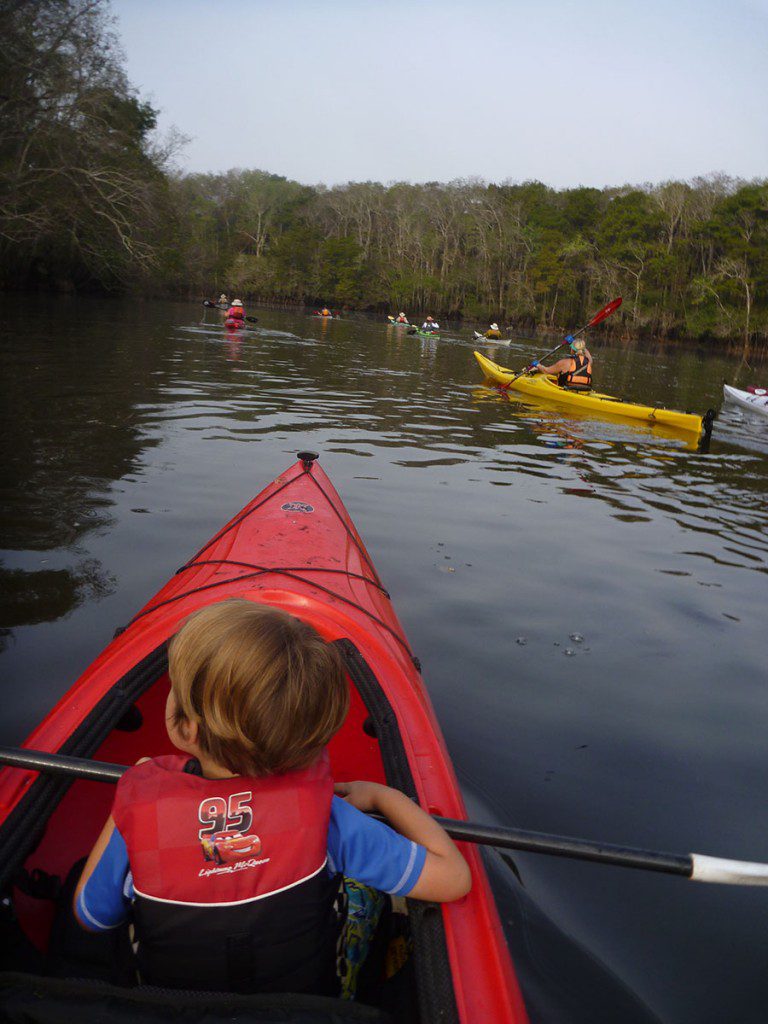 Over a breakfast of pancakes and Bradley’s sausage graciously prepared by RiverTrek husband Warren Jones, I ask Max if he’s ready to go kayaking today.
Over a breakfast of pancakes and Bradley’s sausage graciously prepared by RiverTrek husband Warren Jones, I ask Max if he’s ready to go kayaking today.
“Where are we going?”
“We’re going to the Apalachicola River with everyone, and then they’re going to Apalachicola.” I tell him.
“Can we kayak to Apalachicola?”
“No Max, they’re going to have a hard day. This is the hardest day of the trip.”
Steve Seibert, a first time ‘Trekker, overhears me saying this. “I didn’t need to hear that.”
It can get windy in the river delta, and they may be facing an incoming tide. And it is the longest day from a mileage standpoint. Nevertheless, Max is disappointed that we’re not going the distance.
We get out on the water, and already he’s working the paddle more than on our previous Wakulla River trip.
“Remember, you want to see the smiley face on the paddle.” Georgia has provided him a kid’s paddle. I take time to work with him on his paddling, and then take it from him when he’s tired of it, give it back when he wants to try again, and so on. And like any parent of our times, I take a multitude of photos. We’re at the back of the pack, just as I was on the last two RiverTreks, where I kept shooting video and finding myself working to catch back up.
Soon, we get to the part of the trip that worries me most.
“Bye Max!”
As always when he doesn’t want to say goodbye, he says nothing.
The paddlers head down the Apalach, and I circle around by the entrance to Owl Creek by mile marker 22.2. He always talks about wanting to see the Apalachicola River, but he barely acknowledges it when I tell him that we’re finally here. Max hangs his head. These are good people that just left us, many with children older than Max and that seemed to like playing with a three-year-old again. I can see where he’d miss their company.
He thoughtlessly sticks his hand in the water and lets it drag.
“Max, you have your hand in the Apalachicola River.”
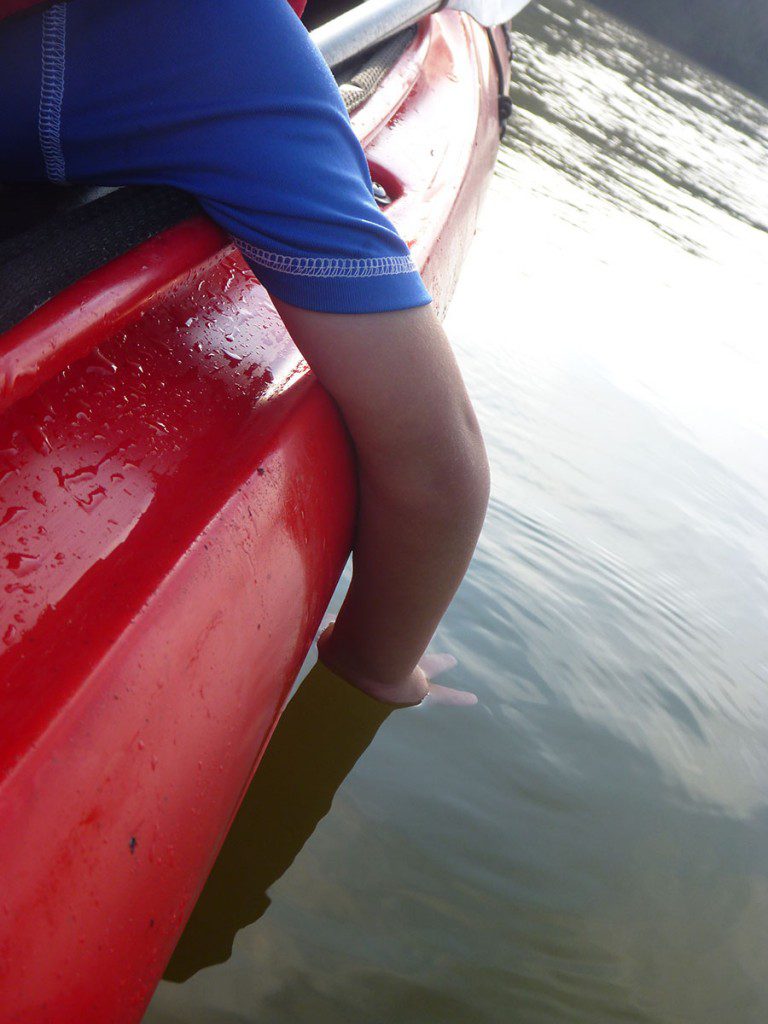 “I do?” He perks up. Now he realizes where he is. Ever since I took this trip two years ago, this has been the magical River of all Rivers, and a Place Where Adventure Happens. He remembers this. And now that he’s getting into it, I do too. I remember where I am, and what a pleasure it has been to paddle these waters. And of course everything I’ve seen in or read about Apalachicola Bay deepens my appreciation and concern for this waterway.
“I do?” He perks up. Now he realizes where he is. Ever since I took this trip two years ago, this has been the magical River of all Rivers, and a Place Where Adventure Happens. He remembers this. And now that he’s getting into it, I do too. I remember where I am, and what a pleasure it has been to paddle these waters. And of course everything I’ve seen in or read about Apalachicola Bay deepens my appreciation and concern for this waterway.
Max and I have the river to ourselves.
We paddle in circles, and he does some of his own paddling. And then we head back up Owl Creek for some lazy exploring. I show him fish hooks hanging from cypress trees. A 2012 photo of a hook that snagged my shirt has previously captured his imagination. We cross through cypress islands. “These trees are where the good honey comes from,” I tell him as I notice how many of the trees are ogeche tupelo.
The highlight of this whole experience starts when we turn into Devin Creek. This canopied side channel was too low for me to properly enjoy during the record low flows of 2012. Today, we paddle under fallen and sideways growing trees, maneuvering from one side of the creek to the other to follow the most navigable path. A johnboat is wedged between trees on the bank. I wonder where its occupant has gone wandering in these dense woods. I could spend all day finding out how far back this creek goes. Eventually, though, I decide to turn us around so that Chris and Jennifer can enjoy some on the water time.
“Let’s stay in here,” he says as we look out from the canopy to Owl Creek. Like on all of these other trips, we do have to leave the river at some point.
When we get back, Max and I sit on the boat ramp as Chris, Jennifer, and her son paddle and swim around the big cypress island by Hickory Landing. Earl comes in on his boat. “This is the creek I where bring out of town visitors,” he tells us. “It’s great for first time paddlers.” I can see spending family days here when Max’s brother is older, the four of us taking turns on a tandem and exploring trails in the forest. We’ll work our way up to that family RiverTrek; it’ll likely take years. We’ll train nice and slowly, like we have today, and we’ll enjoy every bit of the road there.

